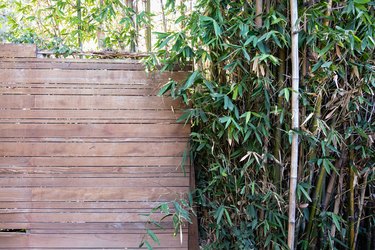Saving a dying lucky bamboo plant often comes down to identifying and correcting the issue that's making it unhealthy. Lucky bamboo (Dracaena sanderiana, USDA zones 9-12) is a relatively easy indoor plant to grow, but it needs proper light, water and container conditions to thrive. When those conditions aren't met, the lucky bamboo plant might start to change colors, droop or show other signs of stress. Get back into a solid care routine to nurse your lucky bamboo plant back to health.
Find an Ideal Location
Video of the Day
Lucky bamboo plants grow best in bright but indirect light. If your lucky bamboo is sunbathing in direct sun all day, the light can cause the leaves to burn and look like they're dying. They often appear yellow and might split with too much sun. Not getting enough bright, indirect light can also affect the plant's growth. It might stretch out, slow down its growth or change its color.
Video of the Day
If you think your bamboo is getting too much direct light, find a bright spot that doesn't get hit directly with sunlight. Make sure you keep up with the watering requirements to help it recover. Holding off on fertilizing can also help your plant recover.
Temperature is also important. Lucky bamboo grows best in temperatures between 65 and 85 degrees Fahrenheit. Find a spot away from drafty windows or doors so outdoor temperatures don't affect the plant, and keep it away from heating and cooling vents that can cause temperature shifts.
Water With Care
You can grow a lucky bamboo plant on soil or in water. The amount of water is important in both cases. If it grows in water, keep the water level replenished regularly to keep the roots submerged. Check at least once per week to see if the bowl needs more water.
For lucky bamboo plants growing on soil, stick your finger into the soil to see if it's dry, or use a soil moisture probe. Keep the soil moist without making it too wet. Even though lucky bamboo can grow in water, it's important not to oversaturate soil because it promotes diseases in the roots.
Fluoride, salt and chlorine in tap water can also cause yellowing in lucky bamboo. Using distilled or filtered water for your lucky bamboo eliminates those potentially harmful components. You can also leave tap water out overnight before using it on the plant to reduce the amounts of chemicals in the water.
Care for the Container
If you grow the lucky bamboo in water, you'll need to clean the container occasionally to keep your bamboo healthy. Algae growing on the container is a sign that it's time to clean. It's usually best to change the water and clean the container and pebbles every seven to 10 days. Sometimes you can wait up to a month before cleaning.
Adjust Lucky Bamboo Plant Fertilizer
Too much fertilizer can cause the lucky bamboo leaves to turn yellow. These plants typically need to be fertilized only about twice per year. If you over fertilize, hold off on fertilizing until the plant recovers, and flush water through its pot to remove some of the fertilizer. If it's just starting to turn yellow, keeping the plant out of direct sunlight and watering with distilled water might allow it to recover. For more severe yellowing, you might need to cut off the damaged bottom and put the bamboo in fresh water or soil.
Correct Root Issues
Root rot is a more severe problem since rotten roots can't take up the nutrients to sustain the plant. Signs of root rot include yellow leaves, slimy roots, a foul smell and brown stems. You can regrow the plant from the healthy tops by cutting them just below one of the raised ridges, or nodes, on the stalk. Use a little rooting hormone powder on the cut end, and put the stalk in water until it grows roots. You can continue growing it in water or transplant it into soil once it has roots.
